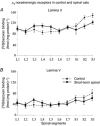Pharmacological aids to locomotor training after spinal injury in the cat
- PMID: 11351014
- PMCID: PMC2278596
- DOI: 10.1111/j.1469-7793.2001.0065b.x
Pharmacological aids to locomotor training after spinal injury in the cat
Abstract
This Topical Review summarizes some of the work we have done mainly in the cat using agonists and antagonists of various neurotransmitter systems injected intravenously or intrathecally to initiate or modulate the expression of hindlimb locomotion after a spinal lesion at T13. The effects of the same drugs are compared in various preparations: complete spinal, partial spinal or intact cats. This has revealed that there can be major differences in these effects. In turn, this suggests that although the locomotor rhythm might normally be triggered and modulated by the activation of a variety of receptors (noradrenaline, serotonin, glutamate), after spinalization there appears to be a predominance of glutamatergic mechanisms. Recent work also suggests that, in the cat, the integrity of the midlumbar segments is crucial for the expression of spinal locomotion. Taken together, this work raises some hope that a targeted pharmacotherapy with better understood drugs and mode and locus of delivery could become a clinical reality.
Figures




Similar articles
-
Comparison of the effect of intrathecal administration of clonidine and yohimbine on the locomotion of intact and spinal cats.J Neurophysiol. 2001 Jun;85(6):2516-36. doi: 10.1152/jn.2001.85.6.2516. J Neurophysiol. 2001. PMID: 11387398
-
Effects of intrathecal glutamatergic drugs on locomotion. II. NMDA and AP-5 in intact and late spinal cats.J Neurophysiol. 2003 Aug;90(2):1027-45. doi: 10.1152/jn.00758.2002. J Neurophysiol. 2003. PMID: 12904502
-
Recovery of locomotion after ventral and ventrolateral spinal lesions in the cat. II. Effects of noradrenergic and serotoninergic drugs.J Neurophysiol. 1999 Apr;81(4):1513-30. doi: 10.1152/jn.1999.81.4.1513. J Neurophysiol. 1999. PMID: 10200188
-
The "beneficial" effects of locomotor training after various types of spinal lesions in cats and rats.Prog Brain Res. 2015;218:173-98. doi: 10.1016/bs.pbr.2014.12.009. Epub 2015 Mar 29. Prog Brain Res. 2015. PMID: 25890137 Review.
-
Recovery of locomotion in the cat following spinal cord lesions.Brain Res Brain Res Rev. 2002 Oct;40(1-3):257-66. doi: 10.1016/s0165-0173(02)00208-4. Brain Res Brain Res Rev. 2002. PMID: 12589924 Review.
Cited by
-
Tolerability and efficacy of erythropoietin (EPO) treatment in traumatic spinal cord injury: a preliminary randomized comparative trial vs. methylprednisolone (MP).Neurol Sci. 2015 Sep;36(9):1567-74. doi: 10.1007/s10072-015-2182-5. Epub 2015 Mar 28. Neurol Sci. 2015. PMID: 25820146 Clinical Trial.
-
Changes in motoneuron properties and synaptic inputs related to step training after spinal cord transection in rats.J Neurosci. 2007 Apr 18;27(16):4460-71. doi: 10.1523/JNEUROSCI.2302-06.2007. J Neurosci. 2007. PMID: 17442831 Free PMC article.
-
Engaging cervical spinal circuitry with non-invasive spinal stimulation and buspirone to restore hand function in chronic motor complete patients.Sci Rep. 2018 Oct 19;8(1):15546. doi: 10.1038/s41598-018-33123-5. Sci Rep. 2018. PMID: 30341390 Free PMC article.
-
To swim or not to swim: regional effects of serotonin, octopamine and amine mixtures in the medicinal leech.J Comp Physiol A Neuroethol Sens Neural Behav Physiol. 2003 Jun;189(6):461-70. doi: 10.1007/s00359-003-0424-0. Epub 2003 May 21. J Comp Physiol A Neuroethol Sens Neural Behav Physiol. 2003. PMID: 12759769
-
Impairment of postural control in rabbits with extensive spinal lesions.J Neurophysiol. 2009 Apr;101(4):1932-40. doi: 10.1152/jn.00009.2008. Epub 2009 Jan 21. J Neurophysiol. 2009. PMID: 19164112 Free PMC article.
References
-
- Baev KV. Rhythmic discharges in hindlimb motor nerves of the decerebrate, immobolized cat induced by intravenous injection of DOPA. Neurophysiology. 1977;9:165–167. - PubMed
-
- Barbeau H, Chau C, Rossignol S. Noradrenergic agonists and locomotor training affect locomotor recovery after cord transection in adult cats. Brain Research Bulletin. 1993;30:387–393. - PubMed
-
- Barbeau H, Julien C, Rossignol S. The effects of clonidine and yohimbine on locomotion and cutaneous reflexes in the adult chronic spinal cat. Brain Research. 1987;437:83–96. - PubMed
-
- Barbeau H, Rossignol S. Recovery of locomotion after chronic spinalization in the adult cat. Brain Research. 1987;412:84–95. - PubMed
-
- Barbeau H, Rossignol S. The effects of serotonergic drugs on the locomotor pattern and on cutaneous reflexes of the adult chronic spinal cat. Brain Research. 1990;514:55–67. - PubMed
MeSH terms
Substances
LinkOut - more resources
Full Text Sources
Medical
Miscellaneous

